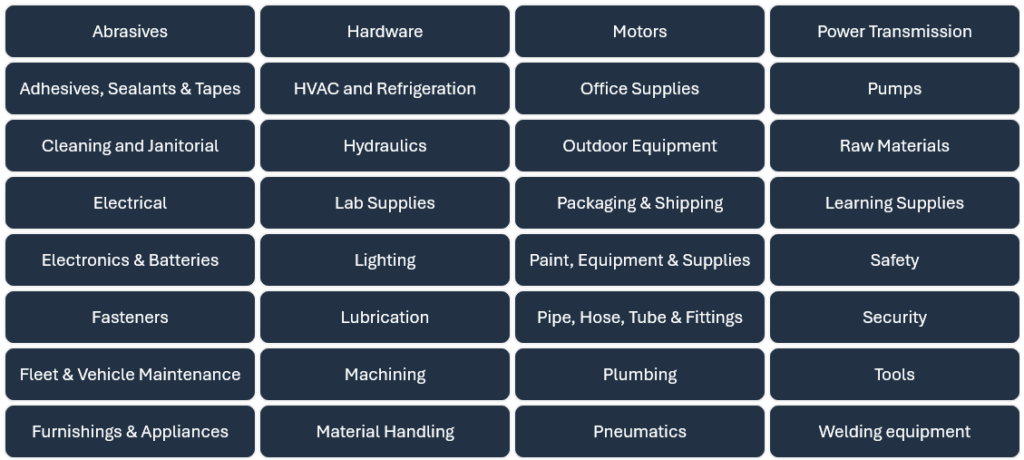
Introduction: Why Appropriate Categorization of MRO Spend Matters
MRO (Maintenance, Repair, and Operations) is one of the largest categories of indirect spend, yet it often remains under-managed. High fragmentation, inconsistent data, and a long tail of SKUs and MRO suppliers continue to challenge even mature procurement organizations.
A major barrier to effective MRO sourcing is the lack of structured, classified data. Without proper categorization:
- Spend visibility remains low
- Purchases are duplicated across sites
- Supplier consolidation opportunities go unrealized
This blog focuses on the critical first step: establishing a robust MRO classification framework. We outline 15 key MRO categories that align with industry standards and common supplier catalog structures. By organizing spend in this way, procurement teams can enable targeted sourcing, improve reporting accuracy, and lay the groundwork for catalog-based procurement across tail spend.
For a more comprehensive sourcing approach, visit our An Expert Guide to MRO Sourcing.
Key MRO Categories

Fig 1 : List of MRO Categories
- Electrical & Electronics
Includes wires, fuses, switches, low-voltage systems, and batteries. With low value, high frequency, and minimal resistance to technical changes, this category benefits from standardization and rationalization. - Safety & PPE
Covers gloves, helmets, protective clothing, respirators, first aid, and facility security products. High variation in PPE items across sites presents a strong opportunity for standardization for example, selecting one make or brand per glove type instead of managing 20. Given compliance requirements, sourcing must balance cost, quality, and user acceptance. - Tools & Hand Equipment
General-purpose tools, power tools, welding kits, and calibration devices. These items are often spread across multiple MRO suppliers, creating significant opportunities for rationalization. - Fasteners & Hardware
Small but essential: screws, nuts, bolts, anchors, and washers. Standardizing specifications across locations helps eliminate duplication and supports catalog-driven sourcing. - Facilities Supplies
Lighting, janitorial items, plumbing parts, HVAC filters, and furniture. Highly fragmented, yet ideal for catalog-based procurement, frequently managed through site-level budgets. - Lubrication & Fluids
Oils, greases, cleaning solvents, and fluid dispensing systems. As these items often support preventive maintenance, bundled sourcing can improve consistency and pricing. - Machining & Fabrication Supplies
Abrasives, welding rods, metalworking fluids, and cutting tools. Needs vary by operation, so sourcing should emphasize durability and supplier technical support. - HVAC & Refrigeration
Thermostats, compressors, filters, ducting, and ventilation components. Strong opportunity to benchmark prices across suppliers as many niche players for these products exist in addition to strategic suppliers - Pumps & Motors
Includes industrial pumps, electric motors, bearings, seals, and mounting kits. These high-value parts are often competitively sourced. Procurement should assess discount structures and service warranties closely. - Material Handling
Shelving, bins, pallet jacks, ladders, and carts. Though not complex, this category directly impacts safety and productivity, making it well-suited for catalog discounts. - Power Transmission
Belts, couplings, pulleys, and chains. Aligning these components with OEM specs improves reliability and avoids costly downtime. - Fleet & Vehicle Maintenance
Filters, fluids, tires, and tools used for on-site vehicles and maintenance fleets. While typically managed locally, centralized sourcing can unlock better volume pricing. - Packaging & Shipping
Tapes, cartons, stretch wrap, void fill, and labeling solutions. A category with high-frequency items but low resistance to change – ideal for long-term vendor agreements. - Office & Administrative
Breakroom supplies, paper products, peripherals, and IT accessories. Although not core MRO, this indirect category is often included in distributor-managed MRO programs. - Lab & Technical Supplies
Labware, calibration instruments, thermometers, and QA/QC tools. Common in manufacturing units such as food, pharmaceuticals, automotive etc.
Why Categorization Drives Better Sourcing Outcomes
Establishing a structured MRO categorization framework is foundational to transforming complexity into opportunity. It empowers procurement professionals to drive value across four key dimensions:
- Enable Strategic RFPs
Organized data allows procurement teams to issue targeted, global or regional RFQs. Suppliers can respond with:
- Market basket quotes
- Category-wide discount structures
- Tiered pricing, rebate programs, and bundled services
This facilitates meaningful bid comparisons and enables total cost of ownership (TCO) optimization.
- Identify Opportunities for Supplier Consolidation
Clear classification highlights duplication across suppliers and sites. Teams can:
- Identify overlap
- Concentrate volume with strategic partners
- Negotiate better pricing and service levels
Supplier rationalization also improves supply chain reliability and reduces administrative workload.
- Improve Forecasting, Budgeting, and Policy Compliance
Categorized spend supports:
- Demand forecasting aligned with maintenance planning
- Budget visibility and control
- Increased compliance through catalog-based procurement and reduced maverick spend
- Strengthen Internal Alignment and Operational Consistency
A shared category structure facilitates:
- Common specifications and sourcing language
- Coordination across decentralized and centralized teams
- Standardized KPIs for tracking sourcing performance
This alignment builds a more cohesive sourcing culture rooted in data-driven decisions.
From Categorization to Action
Categorizing MRO spend is the first step toward effective strategic sourcing enabling targeted RFQs, supplier rationalization, and catalog-driven purchasing.
Explore our Expert Guide to MRO Sourcing to apply these classifications in building comprehensive RFQs, analyzing bids, and driving measurable savings.




